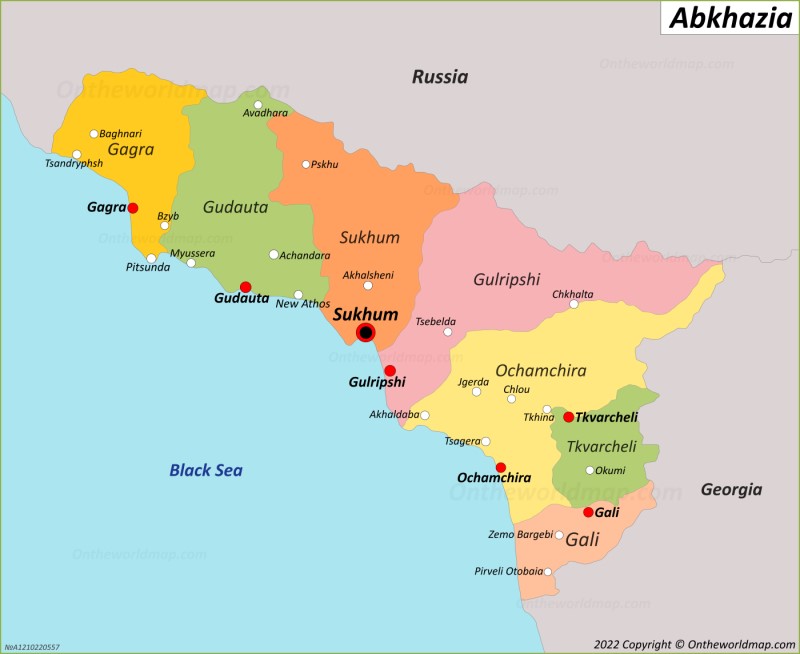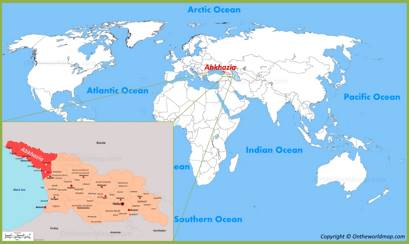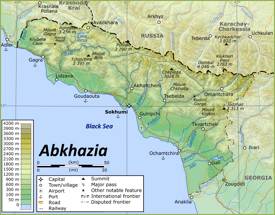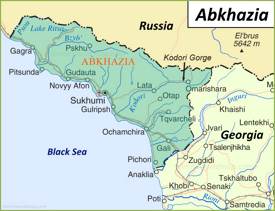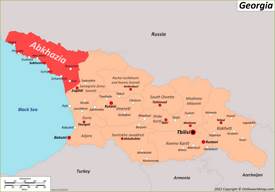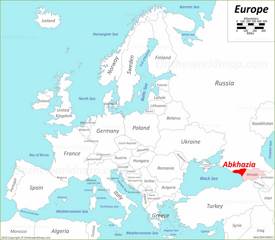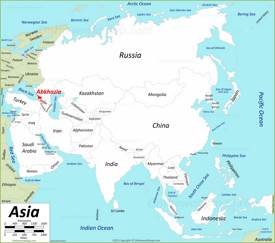Abkhazia Map
Description:
This map shows districts, district capitals, major cities and governmental boundaries of countries in Abkhazia.
Size: 1400x1145px / 306 Kb
Author: Ontheworldmap.com
You may download, print or use the above map for educational, personal and non-commercial purposes. Attribution is required. For any website, blog, scientific research or e-book, you must place a hyperlink (to this page) with an attribution next to the image used.
Online Map of Abkhazia
About Abkhazia
Abkhazia is a region in the South Caucasus, located on the eastern coast of the Black Sea. It is actually controlled by the authorities of the partially recognized Republic of Abkhazia. UN documents consider Abkhazia to be Georgian territory.
Abkhazia borders Russia in the north and Georgia in the east and south. The region covers an area of about 8,660 square kilometers and the landscape is varied with coastal areas, mountains and lush valleys.
The capital of Abkhazia is Sukhumi. This city, located on the Black Sea coast, is the political, cultural and economic center of the region. Other significant cities include Gagra, known for its resorts, and Gudauta, which has historical significance.
Tourism in Abkhazia is developing due to its picturesque landscapes and mild climate. Tourists often visit the beaches along the Black Sea and the Caucasus Mountains. The New Athos Monastery, built in the XIX century, and the New Athos Cave attract tourists interested in history and natural beauty. In addition, Lake Ritsa, located in the mountains, offers scenic views and hiking opportunities.
Abkhazia continues to face complex political and economic challenges. The region is heavily dependent on Russian support, both economically and militarily. Despite its disputed status, Abkhazia strives to maintain its distinct cultural identity and develop its economy, in which tourism plays an important role. However, unresolved political tensions and limited international recognition are persistent obstacles to its development and integration into the wider international community.
The Facts:Capital: Sukhumi.
Area: 3,346 sq mi (8,665 sq km).
Population: ~ 250,000.
Largest cities: Sukhumi, Gagra, Gali, Gudauta, New Athos, Ochamchira, Pitsunda, Tkvarcheli, Bzyb, Gulripshi, Myussera, Gantiadi.
Official language: Abkhaz, Russian.
Currency: Russian ruble, Abkhazian apsar.
Districts of Abkhaziaa: Gagra, Gudauta, Sukhumi, Gulripshi, Ochamchira, Tkvarcheli, Gali.
Status: De jure part of Georgia.
Driving side: right.
Calling code: +7 840 / 940 and +995 44.
Time zone: UTC+3 (MSK).
Google Map of Abkhazia
Geography of Abkhazia
Geographically, Abkhazia presents a varied topography that ranges from low-lying coastal areas to the high peaks of the Caucasus Mountains. The northern border is formed by the Kodori Range, which is part of the Greater Caucasus. This variety of relief results in different microclimates. In the coastal areas, a humid subtropical climate prevails, characterized by mild, wet winters and warm, humid summers. In contrast, the mountainous areas have a more alpine climate, with cooler temperatures and more snow in the winter months.
Brief History of Abkhazia
Historically, Abkhazia traces its roots back to ancient times. In the first millennium B.C. the region was part of the Colchian kingdom, and then was incorporated into the Roman Empire. In the medieval period the Abkhazian Kingdom emerged, which eventually united with the Georgian Kingdom. In the following centuries the region fell under Ottoman and then Russian influence.
In the 20th century, Abkhazia became part of the Soviet Union as an autonomous republic within the Georgian SSR. Following the collapse of the Soviet Union, Abkhazia declared independence from Georgia in 1992, which led to conflict resulting in significant displacement and destruction. Although Abkhazia considers itself an independent state, only a few countries, including Russia, recognize its sovereignty. Most of the international community views it as part of Georgia.

